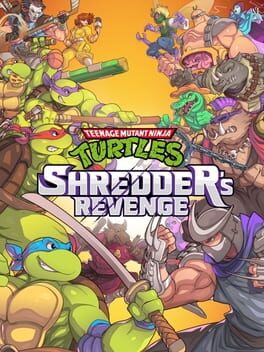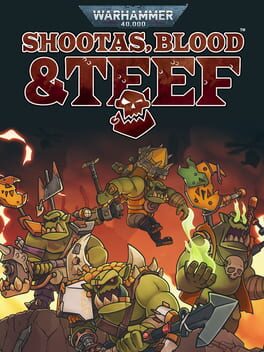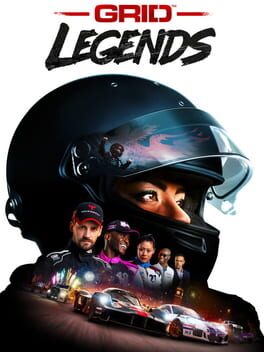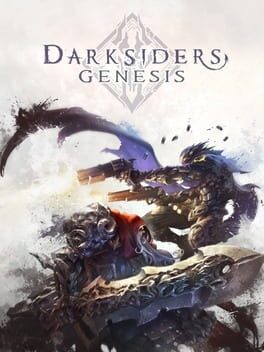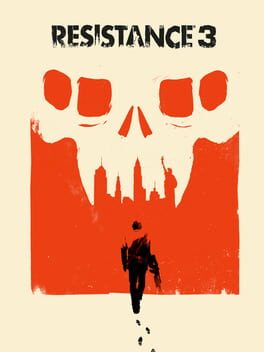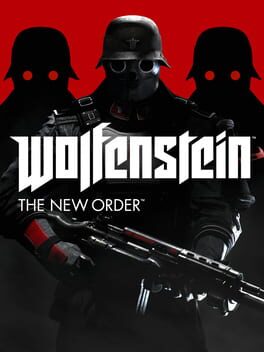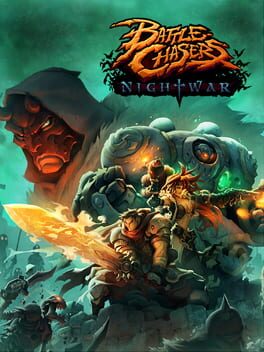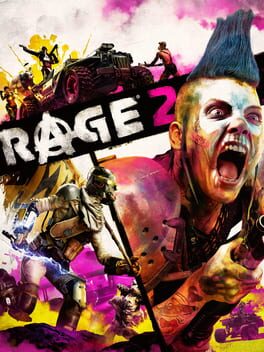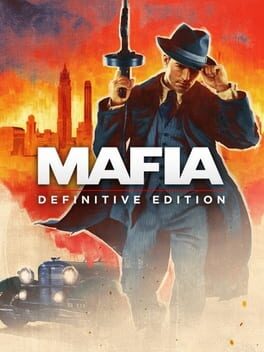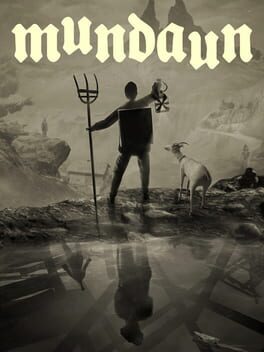homeStyle
Gave up on this after getting to the final boss. Combat is reasonably fun against most of the regular enemies, but basically all the bosses are essentially uncomboable. With the surprising exception of Shredder in the penultimate level, they basically rotate through simple invulnerable-vulnerable phases, with generally unengaging attack patterns. Only a few are interesting in their own right. Most are boring, made aggravating by the presence of adds.
Strongest point in its favour is the story mode basically acting as a chapter select for the arcade mode. That's undermined by including a level system. "Level your favourite turtles up to level 10 so you get full access to supermoves" oh yeah no thank you.
At least it's pretty.
Strongest point in its favour is the story mode basically acting as a chapter select for the arcade mode. That's undermined by including a level system. "Level your favourite turtles up to level 10 so you get full access to supermoves" oh yeah no thank you.
At least it's pretty.
2022
GRID Legends feels more like a product than an empowered artistic attempt. It’s the age-old dilemma in video game criticism, especially reviews. Is the video game reviewer a writer of technology or culture? Are they looking for how well a product works, or how emotionally resonant an artistic endeavour is? As a product, I can’t criticise Legends too much. I didn’t notice any technical problems, certainly no crashes or save issues. Not that I would notice minor framerate or texture issues. My eye is unkeen, you might say. There’s a lot of stuff to unlock, something I would normally criticise, but it feels a little more appropriate here. Cars are machines, after all, and it makes more sense for them to have rigidly controlled stats than it does for fantastical beings and items of power. Maybe I’m being too nice to progression mechanics in my writing lately. I’ll try and make up for that soon, but GRID gets a pass. I can’t review the driving experience at a high level, but as a casual player it scratched the right itch. Everything it attempts it does fine. It’s all fine. There’s just that alluring suggestion of more, of some of that real video game magic, the cinema of ludology that I alluded to when discussing Mafia. It’s all there on the surface, but it isn’t under the hood. The relentless focus on teammates and rivals of the story just isn't reinforced by the gameplay at all, and it just sucks. It feels wrong, weak. Codemasters had a chance to sculpt a masterpiece of interactive narrative on the track, but they chose to script a mildly entertaining docudrama instead. You can play it and enjoy it, but you won’t be gushing about it.
Ground Zeroes was a solid foundation for the future of Metal Gear and the stealth genre more broadly. I’ve always associated Metal Gear Solid with connected level design. I haven’t played much of 1, but I’ve heard there’s backtracking and Shadow Moses is relatively small. Sons of Liberty is the epitome of this, but Snake Eater has some too. Guns of the Patriots was more of a shift to levels, but there’s some room for backtracking and connectedness in the first two acts. Ground Zeroes is level-based Metal Gear done right. There’s so much to the black site; so many ways to enter and exit, so many ways to move through it, so many things to find. Add on top of that the way different missions redesign the placement of enemies, items, and objectives, playing off what remains consistent to put it in a new light. It’s incredible, really. Small play areas have always worked the best for me in stealth games, perhaps because I’m not very good at them (I’m not very good at many games, or many things in general). When it comes to something like Hitman (2016), for example, I kind of loved the demo areas but hated the first actual level. I was overwhelmed by the scope and complexity, and while I understand that that’s what really makes those games fun, I do appreciate the small areas. It’s part of why Splinter Cell: Blacklist was such a guilty pleasure of mine. The different areas of the camp act as mini-staging grounds for stealthy engagements, threaded together as part of a bigger (but not too big) whole. The changes to controls also make it more comfortable to bring a more straightforward shooter mentality to Metal Gear, something others might consider heretical but it’s an option I appreciate. Metal Gear Solid has always been about killing, thematically if not necessarily ludically. It might only be one level, but it’s an awesome level to mess around with.
Unfortunately, the black site isn’t perfectly designed. It often feels cramped, too easy to be spotted, too many open stretches of road and landing zones that Snake can get exposed in. There aren’t many tools for players to mitigate the challenges posed, constrained as Ground Zeroes is by its demo-like nature. It’s still satisfying enough – see my first paragraph, but it’s hard to say whether it needed to give you more items, more choices, or simply be laid out differently. Maybe it’s fine as it is. I had a lot of fun, after all, especially for it only being one level – one that should have been the first of many.
We all know, though, that Ground Zeroes wasn’t the foundation for a level-based masterclass in flexible stealth gameplay design. Instead, Phantom Pain sprung more from its questionable narrative foundation, reincorporating the admittedly somewhat interesting (but grindy, oh so grindy) progression mechanics of Peace Walker alongside the more refined Fox Engine gameplay, and straddling that in an open world. But not an engaging, flexible world that serves as an interesting battleground upon which all these disparate systems come together to form the ultimate open space for tactical espionage action. The open world of Phantom Pain would prove so boring that prerelease videos would fast-forward travel between moments of interest. Not the greatest showcase, even if I ultimately did like both Afghanistan and Africa. The Phantom Pain wasn’t too great, though, and it feels like Ground Zeroes might have been the last great stealth game. Sniper Elite is trying. The ghost of the immersive sim genre is stacking boxes in the corner. Mimimi Games are doing their thing. Stealth is also ubiquitous in the AAA sludge, everywhere yet nowhere, confined to simplification as part of generically approachable corporate-mandated mechanical packages. Ground Zeroes should have been the beginning of both an incredible series of levels, and a resurgence in the genre. It was failed by its successors on all counts.
Unfortunately, the black site isn’t perfectly designed. It often feels cramped, too easy to be spotted, too many open stretches of road and landing zones that Snake can get exposed in. There aren’t many tools for players to mitigate the challenges posed, constrained as Ground Zeroes is by its demo-like nature. It’s still satisfying enough – see my first paragraph, but it’s hard to say whether it needed to give you more items, more choices, or simply be laid out differently. Maybe it’s fine as it is. I had a lot of fun, after all, especially for it only being one level – one that should have been the first of many.
We all know, though, that Ground Zeroes wasn’t the foundation for a level-based masterclass in flexible stealth gameplay design. Instead, Phantom Pain sprung more from its questionable narrative foundation, reincorporating the admittedly somewhat interesting (but grindy, oh so grindy) progression mechanics of Peace Walker alongside the more refined Fox Engine gameplay, and straddling that in an open world. But not an engaging, flexible world that serves as an interesting battleground upon which all these disparate systems come together to form the ultimate open space for tactical espionage action. The open world of Phantom Pain would prove so boring that prerelease videos would fast-forward travel between moments of interest. Not the greatest showcase, even if I ultimately did like both Afghanistan and Africa. The Phantom Pain wasn’t too great, though, and it feels like Ground Zeroes might have been the last great stealth game. Sniper Elite is trying. The ghost of the immersive sim genre is stacking boxes in the corner. Mimimi Games are doing their thing. Stealth is also ubiquitous in the AAA sludge, everywhere yet nowhere, confined to simplification as part of generically approachable corporate-mandated mechanical packages. Ground Zeroes should have been the beginning of both an incredible series of levels, and a resurgence in the genre. It was failed by its successors on all counts.
2019
I… really don’t know what to make of Darksiders Genesis. I think its my favourite Darksiders game – I played the first game around seven years ago, enjoying it for what it was. The sequels, like the industry around them, packed on the numbers and I slid out of them quick. I’d guess I got maybe a quarter of the way through Darksiders II, if that (despite Death being my favourite horseman) and dropped III after only a few hours. I’ve always considered myself a fan, though, and Genesis had me considering going back to explore these entries. There’s something about the aesthetic and the world that does it for me. It might be that it’s only the allure of unfulfilled promises, but at least they’re alluring. The shift to 2D (technically not, but this entry is certainly showing off at least half a dimension less than its numbered forebears) simplifies things. Strife plays like a twin-stick shooter, while War returns with his big sword Chaoseater. They’re both fun to control, and the progression elements didn’t bother be quite as much as most do. The collecting of creature cores helped a little, I guess, even if their minor stat-boosting effects are the stuff of nightmares. There’s a lot to like here, and a lot to dislike.
The first time I played it, I got a few levels in, got stuck, and got out. Thankfully, I tried it again recently and powered through, enjoying most of the middle levels. Like many action games, the puzzles are of little interest, although the perspective shift helps both here and with platforming. There was less frustration with each than my time in I, II, and III. But ultimately a lot of these elements feel like filler, and while moving through the world is generally satisfying, puzzles are less so. Particularly finicky is the use of Strife’s tools in puzzles, which require reasonably precise aim and are activated with R3 (a side effect of giving him two ammo types at a time in combat, a welcome option but generally an unnecessary one). Such problems are exacerbated by 3D parts of the world which can get in the way. It’s enough to make one wonder why they didn’t just commit to 2D, smoothing out these issues alongside the game world. Even more of a problem is the balancing. Despite ostensibly being overlevelled, based on the blanket numbers given for War and Strife (it’s not levelling, it’s accumulation of various things, but you collect similar yet separate powerups so they’re levelled separately – yay)… what was I saying? Oh, yeah: despite ostensibly being overlevelled, I felt underpowered, engagements pointlessly long as I carved my way through bullet- and sword-sponge enemies. It stopped being fun, and was a disappointing way to end my time with the game.
Despite everything, I’d like to see Darksiders make a return. Of course, I’d want any comeback to be on my terms, not the terms it’s operated on – I’d want RPG elements stripped out entirely (fun merchants like Vulgrim and Dis can stay, don’t worry; we’ll find something for them to do) and a reduced puzzle presence. If I had to pick one to get done, it’d be the former. With God of War (alongside everything else) now an action-RPG, it would be great to see the series step into the limelight as a simplified throwback action game, with platforming spectacle to complement the violence. Perhaps a soft reboot, if necessary, with a single protagonist wielding the weapons of each horseman. I know though, as we all should, that if it returns it will be rife with industry trends and overstuffed with ideas, not a sleek challenge to an industry intent on barrelling down the wrong path. Ah, well, we can only dream.
(Whoops, broke my personal guidelines and got a little wistful there)
The first time I played it, I got a few levels in, got stuck, and got out. Thankfully, I tried it again recently and powered through, enjoying most of the middle levels. Like many action games, the puzzles are of little interest, although the perspective shift helps both here and with platforming. There was less frustration with each than my time in I, II, and III. But ultimately a lot of these elements feel like filler, and while moving through the world is generally satisfying, puzzles are less so. Particularly finicky is the use of Strife’s tools in puzzles, which require reasonably precise aim and are activated with R3 (a side effect of giving him two ammo types at a time in combat, a welcome option but generally an unnecessary one). Such problems are exacerbated by 3D parts of the world which can get in the way. It’s enough to make one wonder why they didn’t just commit to 2D, smoothing out these issues alongside the game world. Even more of a problem is the balancing. Despite ostensibly being overlevelled, based on the blanket numbers given for War and Strife (it’s not levelling, it’s accumulation of various things, but you collect similar yet separate powerups so they’re levelled separately – yay)… what was I saying? Oh, yeah: despite ostensibly being overlevelled, I felt underpowered, engagements pointlessly long as I carved my way through bullet- and sword-sponge enemies. It stopped being fun, and was a disappointing way to end my time with the game.
Despite everything, I’d like to see Darksiders make a return. Of course, I’d want any comeback to be on my terms, not the terms it’s operated on – I’d want RPG elements stripped out entirely (fun merchants like Vulgrim and Dis can stay, don’t worry; we’ll find something for them to do) and a reduced puzzle presence. If I had to pick one to get done, it’d be the former. With God of War (alongside everything else) now an action-RPG, it would be great to see the series step into the limelight as a simplified throwback action game, with platforming spectacle to complement the violence. Perhaps a soft reboot, if necessary, with a single protagonist wielding the weapons of each horseman. I know though, as we all should, that if it returns it will be rife with industry trends and overstuffed with ideas, not a sleek challenge to an industry intent on barrelling down the wrong path. Ah, well, we can only dream.
(Whoops, broke my personal guidelines and got a little wistful there)
2011
My PS3 disc drive doesn’t work anymore and I can’t really be bothered getting it fixed. That’s not a huge problem, but it means there’s a few games I might never play again. Among them are old favourites (and guilty pleasures) like inFamous, Guns of the Patriots, Splinter Cell: Blacklist, Resistance, and Resistance 2. But it’s the idea of never replaying Resistance 3 that seems most tragic. It’s the ultimate refinement of what came before, finally bringing together and improving on the gunplay, visuals, and pacing. It’s a blast to play, all the more odd for coming in the middle of Insomniac’s rough patch. There’s a chance that it doesn’t hold up, that part of why it was so good was because the rest of the seventh gen was so bad. But I’m putting my money on that not being the case. Besides, have games really gotten much better since? I’d certainly take a linear shooter campaign with simple progression the vein of Resistance 3 over Destiny or Borderlands or Fallout. According to my trophies, I seem to have completed it in a few days. Maybe it just took me a while to earn that first one. But it’s the kind of game you can just blast through, and that’s what an FPS campaign is supposed to be.
All these years later, it’s tough to remember what I disliked about Resistance 3. Sure, the story isn’t that great (although the aesthetic goes some way into compensating there – what wonderful things art direction can do for tone). Sometimes the weapons could feel a little underwhelming, but they’re so much better than what most shooters do it would be greedy to ask for more. I’m just too hard to please. I think level design stands out as the big gameplay weakness, although I can’t really remember what my problems with it were. I think combat spaces tended to mould more into the circular arenas, similar to later shooters like DOOM (2016) and DOOM Eternal (2020), but with a gameplay style more suited to progressing through levels. Maybe it’s just the combat arenas standing out to me now because I spent more time fighting in them, but I remember so many of those and so few times when enemies popped up as I moved through parts of conquered America.
If you’ll let me blatantly dream like a fanboy, I’ve always wanted a Resistance prequel set in Russia (in the 1930s or so, not 100% on the l o r e) that takes inspiration from Metro (and maybe STALKER? – haven’t played that one). Ultimately, it’s disappointing that the Resistance series was ended as abruptly as the Chimera threat. Right as it seemed to have conquered the world, it was snuffed out. Well, maybe that’s forcing the comparison a bit, but it had certainly found something. Weirdly, though, the spirit of Resistance 3 lives on in Rage 2. Shield that protects you from enemy bullets? Check. Revolver that embeds bullets in enemies for activation by its secondary mode? Check. Disappointing shotgun given the strength of the arsenal around it? Check. Slightly odd guns that aren’t really as fun as just using the ones that shoot enemies? Yeah, check. Never quite got on with the mutator or cryogun. But they were there and that’s enough. I still love Resistance 3.
All these years later, it’s tough to remember what I disliked about Resistance 3. Sure, the story isn’t that great (although the aesthetic goes some way into compensating there – what wonderful things art direction can do for tone). Sometimes the weapons could feel a little underwhelming, but they’re so much better than what most shooters do it would be greedy to ask for more. I’m just too hard to please. I think level design stands out as the big gameplay weakness, although I can’t really remember what my problems with it were. I think combat spaces tended to mould more into the circular arenas, similar to later shooters like DOOM (2016) and DOOM Eternal (2020), but with a gameplay style more suited to progressing through levels. Maybe it’s just the combat arenas standing out to me now because I spent more time fighting in them, but I remember so many of those and so few times when enemies popped up as I moved through parts of conquered America.
If you’ll let me blatantly dream like a fanboy, I’ve always wanted a Resistance prequel set in Russia (in the 1930s or so, not 100% on the l o r e) that takes inspiration from Metro (and maybe STALKER? – haven’t played that one). Ultimately, it’s disappointing that the Resistance series was ended as abruptly as the Chimera threat. Right as it seemed to have conquered the world, it was snuffed out. Well, maybe that’s forcing the comparison a bit, but it had certainly found something. Weirdly, though, the spirit of Resistance 3 lives on in Rage 2. Shield that protects you from enemy bullets? Check. Revolver that embeds bullets in enemies for activation by its secondary mode? Check. Disappointing shotgun given the strength of the arsenal around it? Check. Slightly odd guns that aren’t really as fun as just using the ones that shoot enemies? Yeah, check. Never quite got on with the mutator or cryogun. But they were there and that’s enough. I still love Resistance 3.
This might be blasphemy considering the ideals I hold up in combat systems, but I’ve never looked down on the Arkham combat system. It’s worn out its welcome with me, but I appreciate it as both a fun visual experience and a rhythmic challenge. I’d compare it to something like Yakuza combat? Fun enough, can serve as the gameplay backbone of a narrative experience (further helped by the variety used around it in both franchises), not as engaging as the masters. The stealth (or predator) gameplay is similarly more advanced than the basic stuff we see in most standard modern AAA output. It’s the polished slickness of these systems that puts the franchise above water compared to its peers. And it’s the atmosphere of Asylum that keeps it up to the standard of its sequels despite their gameplay refinements. Weird moments aside (titan Joker, nurse Harley, etc) it’s a great rendition of the world of Batman, limited as the scope of the world is. At least those limitations mean you don’t have to justify empty streets over and over and over – hello City, Origins, Knight, how are you and where did the civilians go? Like many superhero adaptations (before the explosion of the MCU and the drive towards universes), it largely ignores the existence of the wider DC world in favour of prioritising its hero as a singular superheroic figure. Batman is having an awful night, but he’s up to the challenge.
I don’t believe that Arkham Asylum was the perfect Batman experience, nor the best of the Arkham games. While its structure certainly helps sell it, I don’t think Batman is at his best when he’s stuck in Arkham. If he is, Morrison did it better (and then fifteen years later they did a real Batman story (sidenote: Wikipedia probably needs a pronouns section for notable modern individuals)). Its gameplay is also a little rough, especially the freeflow combat system. Rocksteady improved it just a little for City, say 10-20% or so, but that 10-20% meant a hell of a lot.
I don’t have any wishes for this one. City refined it. I don’t think you can ask for anything more from the first game in a franchise to be great in its own right even as it lays the groundwork for something better.
I don’t believe that Arkham Asylum was the perfect Batman experience, nor the best of the Arkham games. While its structure certainly helps sell it, I don’t think Batman is at his best when he’s stuck in Arkham. If he is, Morrison did it better (and then fifteen years later they did a real Batman story (sidenote: Wikipedia probably needs a pronouns section for notable modern individuals)). Its gameplay is also a little rough, especially the freeflow combat system. Rocksteady improved it just a little for City, say 10-20% or so, but that 10-20% meant a hell of a lot.
I don’t have any wishes for this one. City refined it. I don’t think you can ask for anything more from the first game in a franchise to be great in its own right even as it lays the groundwork for something better.
2011
Resident Evil 4 is brilliant. If it was only its combat system, it would be one of the best games I’ve ever played. But it isn’t, and it adds on top of that incredible pacing, length, charm, humour, bonus modes, and new game plus features. It’s the definition of a complete package.
Quick time events suck. I guess holding a button to run also isn’t the greatest.
Resident Evil 4 is not outdated. It is still one of the best combat systems ever designed, and it’s a shame that it has been so hard to follow in its wake.
Quick time events suck. I guess holding a button to run also isn’t the greatest.
Resident Evil 4 is not outdated. It is still one of the best combat systems ever designed, and it’s a shame that it has been so hard to follow in its wake.
This game was special. Bombastic yet introspective, hyper-violent yet soulful, this latest Wolfenstein reboot was carried by its character work, most notably the reserved, righteous Nazi-killer BJ Blazkowicz. Sublime aesthetic, earnest emotions, and most evil bad guys ever make for a hell of an action-adventure experience. Gameplay-wise, its reception is probably the benefactor of both the changes made to its direct successors and the timing of its release. If DOOM (2016) had been DOOM (2013), The New Order might have seemed limper. If The New Colossus (which I haven’t played) hadn’t leaned into cutscenes and stripped BJ of his health, or Youngblood hadn’t gone co-op with levelled enemies (yucko), the combat foundation established in this first game would have either become stale or been surpassed, rather than actively made worse. As it is, its fun enough, better viewed as an improvement of the trends common to seventh-gen singleplayer FPS.
The combat is also the most obvious weak point of the experience. By the final stretch of the campaign I’d tired of it, turning the difficulty down to cruise through the rest of the experience. It’s uncomfortable in a way that feels like a failure on the part of the game rather than my own – too many cramped or uninteresting levels, enemies that aren’t that interesting to fight, an unwillingness to let you off the leash with your full arsenal. For all the willingness to get crazy, you spend a lot of time shooting a fairly standard assault rifle. It would also be nice if you didn’t have to press square to pick up every single little piece of ammunition, armour, and health.
I like to end these reviews with a “wish”, recognising something genuinely great or at least offering promise and potential, putting that to the fore as my conclusion. Here, it’s less something to do with the game itself, and more the path of their developer. MachineGames has made five games in this iteration of the Wolfenstein series. I’m not too fond of where they’ve taken it after such a promising first step, and I can only hope they can recapture that form with Indiana Jones and whatever IP they’re allowed to go hard with after that.
The combat is also the most obvious weak point of the experience. By the final stretch of the campaign I’d tired of it, turning the difficulty down to cruise through the rest of the experience. It’s uncomfortable in a way that feels like a failure on the part of the game rather than my own – too many cramped or uninteresting levels, enemies that aren’t that interesting to fight, an unwillingness to let you off the leash with your full arsenal. For all the willingness to get crazy, you spend a lot of time shooting a fairly standard assault rifle. It would also be nice if you didn’t have to press square to pick up every single little piece of ammunition, armour, and health.
I like to end these reviews with a “wish”, recognising something genuinely great or at least offering promise and potential, putting that to the fore as my conclusion. Here, it’s less something to do with the game itself, and more the path of their developer. MachineGames has made five games in this iteration of the Wolfenstein series. I’m not too fond of where they’ve taken it after such a promising first step, and I can only hope they can recapture that form with Indiana Jones and whatever IP they’re allowed to go hard with after that.
I played this a long time ago so this won’t be the most detailed review.
For a time, this was my favourite JRPG. Nowadays, I prefer TRPGs more, the elements introduced alongside movement and positioning an important part of the experience to me. But sometimes you still want to line up and fight some monsters on the spot, and Nightwar did it damn well. There’s a fun roster for your party (six characters to fill three active slots), each with a range of upgrades that allow you to sculpt the way they fill their niche. What Nightwar did best was its mana system, with an overcharge mechanic building on top of the traditionally available resource. Overcharge was essentially mana confined to a single battle, shifting players’ thinking from a long-term approach per dungeon to a short-term, per battle focus. From strategy to tactics, if you will. Most attacks interact with the system in some way, some building overcharge and others consuming it to alter the attack properties. Between the moment-to-moment strengths of the overcharge system and the options in party-building, it was a great way for me to check out a genre I’d often disliked, and learn to appreciate some of its strengths.
Looking back, the main criticism I’d make is regarding difficulty. I don’t remember this game pushing me very often, and few opponents encouraged thoughtful play. In an odd situation for me, I can’t really criticise the implementation of progression here, because I mostly enjoyed how it was done. Maybe I’ll change my mind on replay.
I’d like to see a version of this battle system that pushes overcharge further to the front. It was very rare that I used my actual mana reserves, and I think removing them entirely would have made the game more interesting. Reworking overcharge to be this important would probably have to be accompanied by a shift to longer battles, perhaps more multi-stage ones alongside tougher opponents, but I think it’s a change that could work. Or maybe overcharge only works if it’s a clear extra. Can’t really say.
For a time, this was my favourite JRPG. Nowadays, I prefer TRPGs more, the elements introduced alongside movement and positioning an important part of the experience to me. But sometimes you still want to line up and fight some monsters on the spot, and Nightwar did it damn well. There’s a fun roster for your party (six characters to fill three active slots), each with a range of upgrades that allow you to sculpt the way they fill their niche. What Nightwar did best was its mana system, with an overcharge mechanic building on top of the traditionally available resource. Overcharge was essentially mana confined to a single battle, shifting players’ thinking from a long-term approach per dungeon to a short-term, per battle focus. From strategy to tactics, if you will. Most attacks interact with the system in some way, some building overcharge and others consuming it to alter the attack properties. Between the moment-to-moment strengths of the overcharge system and the options in party-building, it was a great way for me to check out a genre I’d often disliked, and learn to appreciate some of its strengths.
Looking back, the main criticism I’d make is regarding difficulty. I don’t remember this game pushing me very often, and few opponents encouraged thoughtful play. In an odd situation for me, I can’t really criticise the implementation of progression here, because I mostly enjoyed how it was done. Maybe I’ll change my mind on replay.
I’d like to see a version of this battle system that pushes overcharge further to the front. It was very rare that I used my actual mana reserves, and I think removing them entirely would have made the game more interesting. Reworking overcharge to be this important would probably have to be accompanied by a shift to longer battles, perhaps more multi-stage ones alongside tougher opponents, but I think it’s a change that could work. Or maybe overcharge only works if it’s a clear extra. Can’t really say.
2020
Although many would describe it as a beat-em-up, it eschews some of the hallmarks of the genre in favour of an experience that courts more mainstream attention. With a level-based (rather than arcade) campaign, skill trees and item unlocks, and a focus on story sections, I would consider it more broadly in the 2D action genre, refuting the more specific descriptor. I enjoyed my time with it, although it was not particularly ground-breaking and in the end broke itself.
9 Monkeys most obvious departure from the beat-em-up formula is the prominence of its story. Not every mission is heavy on the story, but the opening prologue includes a forced loss which leads to protagonist Wei Cheng’s recovery and training in the care of Buddhist monks. Wei Cheng ultimately masters their techniques and takes a new name as he joins them, achieving first revenge and then overcoming a threat of greater scope. For all the emphasis on it, the story did not interest me much. If I compare it to Fight’N Rage, which had a more engaging story that could easily be taken out of the way, or River City Girls, which had a more amusing story that was less easily ignored, the tale of 9 Monkey is not particularly engaging or novel, instead bogging down missions (especially on replay). If part of the pitch of this game was drawing a more casual crowd to the genre with this concession, it wasn’t worth it and I doubt it proved effective.
More effective is the simple gameplay. Most attacks are performed with three of the face buttons, with which players can kick enemies or slash and thrust at them with Wei Cheng’s staff. Three forms of modifiers to these buttons (holding them, or holding L2 or R2 before pressing them) use a resource bar (qi, gained by fighting enemies and modified by equipable items). Qi allows Wei Cheng to use more powerful moves, giving him better combo options and control of space. His moveset is rounded out by a dodge and a parry, each of which is relatively easy to pull off for the genre but has a bit of recovery on the back end. When I got into a nice flow with my parries, I felt untouchable for the evening. But the next day, when I hit the button too early almost every time, I got picked apart by ruthless foes. There’s a good flow to the combat system, once you get comfortable, based around spacing and parrying and ensuring you don’t get surrounded. In another break from the typical beat-em-up formula, there’s no sense of lanes (outside of the level with sawblades travelling through the floor). Control of space feels like a natural challenge, although one that quickly becomes too easy. What ultimately breaks the game is the Seal of Attraction, which, with the right item loadout, has basically infinite use. Spamming one move (with no execution barrier) then carried me through every level on the hardest difficulty (although without the accompanying trophy popping, much to my chagrin). There are also four consumable items to help players, each a different flavour of tea found in breakable items throughout the stages. One restores health, two reduce and increase damage respectively, and the last temporarily gives infinite qi. They can help you through a few tough spots, but I often ended levels with a surplus of tea in my inventory.
Unfortunately, being a modern game, 9 Monkeys of Shaolin has a skill tree alongside its unlocks. Really, it has nine skill trees, one for each of your attacks. And each attacks’ tree has 2 components – raw damage increase, as well as upgrades to the properties of the move – longer duration, wider reach, new effects. When I had invested properly, I went from thinking enemies were a bit too tough for such a limited combo system to carving through them with ease. Discovering the Seal of Attraction tactic certainly didn’t help. It’s not like that’s a particularly difficult thing to figure out; I’m not normally someone that min-maxes or breaks games in any way. I just happened into the optimal strategy due to getting frustrated with the ghost enemies (who can typically only be damaged by qi attacks). The weaknesses of the combat system and reliance on skill tree unlocks further distance 9 Monkeys from the strengths of the beat-em-up genre.
Overall, 9 Monkeys of Shaolin is a fun 2D action game that serves as a fun companion to the more traditional, hardcore beat-em-ups. It’s worth at least a few hours of attention from casual players, just to see what’s there. Perhaps you could bring a friend rather than going alone as I did. If the glitched trophy had unlocked for me I might be a little happier right now, but ultimately I’m not going to recognise this game as some unheralded masterpiece. It’s a solid game that does some things well, but fails to fulfil the core appeal of the beat-em-up genre, let down by both its core combat and progression structure. With narrative sensibilities rather than arcade ones, it lacks appeal for the hardcore crowd, but is nonetheless enjoyable through most of its missions. Just hold off on the Seal of Attraction loops until you’re sure you’re done with it.
9 Monkeys most obvious departure from the beat-em-up formula is the prominence of its story. Not every mission is heavy on the story, but the opening prologue includes a forced loss which leads to protagonist Wei Cheng’s recovery and training in the care of Buddhist monks. Wei Cheng ultimately masters their techniques and takes a new name as he joins them, achieving first revenge and then overcoming a threat of greater scope. For all the emphasis on it, the story did not interest me much. If I compare it to Fight’N Rage, which had a more engaging story that could easily be taken out of the way, or River City Girls, which had a more amusing story that was less easily ignored, the tale of 9 Monkey is not particularly engaging or novel, instead bogging down missions (especially on replay). If part of the pitch of this game was drawing a more casual crowd to the genre with this concession, it wasn’t worth it and I doubt it proved effective.
More effective is the simple gameplay. Most attacks are performed with three of the face buttons, with which players can kick enemies or slash and thrust at them with Wei Cheng’s staff. Three forms of modifiers to these buttons (holding them, or holding L2 or R2 before pressing them) use a resource bar (qi, gained by fighting enemies and modified by equipable items). Qi allows Wei Cheng to use more powerful moves, giving him better combo options and control of space. His moveset is rounded out by a dodge and a parry, each of which is relatively easy to pull off for the genre but has a bit of recovery on the back end. When I got into a nice flow with my parries, I felt untouchable for the evening. But the next day, when I hit the button too early almost every time, I got picked apart by ruthless foes. There’s a good flow to the combat system, once you get comfortable, based around spacing and parrying and ensuring you don’t get surrounded. In another break from the typical beat-em-up formula, there’s no sense of lanes (outside of the level with sawblades travelling through the floor). Control of space feels like a natural challenge, although one that quickly becomes too easy. What ultimately breaks the game is the Seal of Attraction, which, with the right item loadout, has basically infinite use. Spamming one move (with no execution barrier) then carried me through every level on the hardest difficulty (although without the accompanying trophy popping, much to my chagrin). There are also four consumable items to help players, each a different flavour of tea found in breakable items throughout the stages. One restores health, two reduce and increase damage respectively, and the last temporarily gives infinite qi. They can help you through a few tough spots, but I often ended levels with a surplus of tea in my inventory.
Unfortunately, being a modern game, 9 Monkeys of Shaolin has a skill tree alongside its unlocks. Really, it has nine skill trees, one for each of your attacks. And each attacks’ tree has 2 components – raw damage increase, as well as upgrades to the properties of the move – longer duration, wider reach, new effects. When I had invested properly, I went from thinking enemies were a bit too tough for such a limited combo system to carving through them with ease. Discovering the Seal of Attraction tactic certainly didn’t help. It’s not like that’s a particularly difficult thing to figure out; I’m not normally someone that min-maxes or breaks games in any way. I just happened into the optimal strategy due to getting frustrated with the ghost enemies (who can typically only be damaged by qi attacks). The weaknesses of the combat system and reliance on skill tree unlocks further distance 9 Monkeys from the strengths of the beat-em-up genre.
Overall, 9 Monkeys of Shaolin is a fun 2D action game that serves as a fun companion to the more traditional, hardcore beat-em-ups. It’s worth at least a few hours of attention from casual players, just to see what’s there. Perhaps you could bring a friend rather than going alone as I did. If the glitched trophy had unlocked for me I might be a little happier right now, but ultimately I’m not going to recognise this game as some unheralded masterpiece. It’s a solid game that does some things well, but fails to fulfil the core appeal of the beat-em-up genre, let down by both its core combat and progression structure. With narrative sensibilities rather than arcade ones, it lacks appeal for the hardcore crowd, but is nonetheless enjoyable through most of its missions. Just hold off on the Seal of Attraction loops until you’re sure you’re done with it.
2019
I was under the impression this game sucked, entirely deflating after the expectations that had built up during the marketing cycle. I guess I’m now on the upswing of that hype backlash, because I thought it was a fun time all round. It has weapons and abilities that are more fun to use than most, it has enemies that are fun to fight, it has an interesting if undercooked vehicle structure. The short story works in its favour, placing the emphasis on the open world checklist. Each activity serves as a separate combat encounter, with Ark locations the most worth seeking out, as they provide powerups. But they aren’t necessary either – I finished the game only having unlocked around half the weapon wheel and a slightly greater proportion of the powers.
Make no mistake, the gameplay isn’t some unheralded masterpiece. Despite the involvement of iD, it’s certainly no Doom. And yet I’d much rather shoot enemies in this than I would in any given Far Cry game. The story is by far the weakest part, and skipping it can sometimes mean skipping three or four consecutive cutscenes. That’s what I did – I wasn’t messing around with this one. Unfortunately, some walk-and-talk sequences, along with elevator rides and similar, slow the pace. Luckily, the story is just as short and disposable as the rest of the game.
The biggest place to improve on would be the car combat. Whereas that was a real strength of Mad Max, the other non-Just Cause game from Avalanche, here it’s a big let-down. The driving itself was okay, nothing special (although I’ve spoiled myself by playing a proper racing game recently), but even with the upgrades to Walker’s Phoenix fighting other vehicles just felt so limp.
Make no mistake, the gameplay isn’t some unheralded masterpiece. Despite the involvement of iD, it’s certainly no Doom. And yet I’d much rather shoot enemies in this than I would in any given Far Cry game. The story is by far the weakest part, and skipping it can sometimes mean skipping three or four consecutive cutscenes. That’s what I did – I wasn’t messing around with this one. Unfortunately, some walk-and-talk sequences, along with elevator rides and similar, slow the pace. Luckily, the story is just as short and disposable as the rest of the game.
The biggest place to improve on would be the car combat. Whereas that was a real strength of Mad Max, the other non-Just Cause game from Avalanche, here it’s a big let-down. The driving itself was okay, nothing special (although I’ve spoiled myself by playing a proper racing game recently), but even with the upgrades to Walker’s Phoenix fighting other vehicles just felt so limp.
2016
Every now and then, Bad Moon Rising re-enters my head and I have a flashback to Lincoln Clay cruising through the rural roads around New Bordeaux. The aesthetic of this game is incredible. Despite quitting early, moments like these stuck in my head. The story was promising too, and the gang set-up with 3 underbosses was a good idea.
Unfortunately, Mafia III goes hard away from the open world of its predecessor (I haven’t played II). Where the pacing and structure of Mafia: Definitive Edition overrode my apathy towards it, pulling me through the game, the severe repetition of III drove me away. When I was in the empty parts of the world, I loved it. When a mission was more handcrafted, I enjoyed it well enough. But its just such a slog of an open world.
I would love a version of Mafia III that actually told me Lincoln Clay’s story, that leaned in to the vibe of driving through sad streets to the sound of contemporary rock. But this game wants you to check off a lot of lists.
Unfortunately, Mafia III goes hard away from the open world of its predecessor (I haven’t played II). Where the pacing and structure of Mafia: Definitive Edition overrode my apathy towards it, pulling me through the game, the severe repetition of III drove me away. When I was in the empty parts of the world, I loved it. When a mission was more handcrafted, I enjoyed it well enough. But its just such a slog of an open world.
I would love a version of Mafia III that actually told me Lincoln Clay’s story, that leaned in to the vibe of driving through sad streets to the sound of contemporary rock. But this game wants you to check off a lot of lists.
The best thing Mafia has going for it is pacing. Its pacing carried me through, from mission to mission to mission. It’s legitimately impressive.
Unfortunately, it’s so impressive because everything is so unengaging. The story is bland. The gameplay is bland. The world is underutilised. Why did I play this game? I guess it was the pacing.
One thing I would have liked to see was better use of the open world. Not side missions or anything of the sort, but missions that made better use of having an entire city available to them. It’s a defining aspect of the game after all. Why was it so restricted to drives between missions and a separate free roam mode? Outside of chases, the missions which made good use of it include the opening taxi mission and tracking down a man to kill. But there could have been more, and it could have been used to sell the story of the gang so much more interestingly.
Unfortunately, it’s so impressive because everything is so unengaging. The story is bland. The gameplay is bland. The world is underutilised. Why did I play this game? I guess it was the pacing.
One thing I would have liked to see was better use of the open world. Not side missions or anything of the sort, but missions that made better use of having an entire city available to them. It’s a defining aspect of the game after all. Why was it so restricted to drives between missions and a separate free roam mode? Outside of chases, the missions which made good use of it include the opening taxi mission and tracking down a man to kill. But there could have been more, and it could have been used to sell the story of the gang so much more interestingly.
2021
An excellent little adventure game, light on gameplay systems but with enough there to keep you engaged. All of the little interactions with the world add enough flavour to entertain, and further justify its existence as a game rather than in a more passive storytelling medium. Driving the Muvel is a particular highlight. There isn't much to it, but finally getting the keys and cruising around the mountainside in that thing was an enjoyable time.
Unfortunately, enemies suck. It's nice that they're there, justifying several gameplay systems (player upgrades, the gun, pitchforks, several items) but it would have been nice if they were a bit easier to work around. Ultimately, I think it's good that they were included to avoid the game being a walking simulator or something in the vein of Outlast, but it would have been nicer for the execution to have been more engaging.
Unfortunately, enemies suck. It's nice that they're there, justifying several gameplay systems (player upgrades, the gun, pitchforks, several items) but it would have been nice if they were a bit easier to work around. Ultimately, I think it's good that they were included to avoid the game being a walking simulator or something in the vein of Outlast, but it would have been nicer for the execution to have been more engaging.
